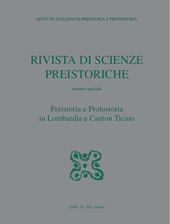La terramara di Prestinari (Roverbella, MN) e altri siti dell'età del Bronzo lungo il paleoalveo della Fossa Molinella
P. 493-503
Systematic surveys at Roverbella have led to the discovery of many sites scattered across an area crossed by the meandering palaeo-channels of an ancient spring-fed watercourse, which did affect quite substantially the ancient settlement patterns in this area. The aerial photographs taken in correspondence of the Bronze Age settlement of Corte Prestinari (site P) have revealed features suggesting the presence of a small, trenched village (‘terramara'), built within the ancient palaeo-channel. Many other scatterings of prehistoric finds have been detected in this palaeo-valley: their distribution could suggest the existence of a diffuse settlement network during the Early Bronze Age, followed by a concentration of the population in a few, more stable sites during the Middle Bronze Age.
A general depopulation of the whole territory might have occurred at the end of the first phase of this period, and the number of sites plummeted quite sharply with the Late Bronze Age. Although morphologically higher areas had been chosen for the foundation of new villages during the Middle Bronze Age 2 and the Late Bronze Age, the ‘terramara' of Corte Prestinari, lying right inside the palaeo-channel, was not abandoned. During the Middle Bronze Age 2B phase, a new occupation was underway in a nearby site (site P8) and at Prestinari itself (site P), where it was going to last until the beginnings of the Late Bronze Age. This long occupation suggests a strategic importance of the headwaters area that one could connect with the maintenance of the springs, involving (perhaps) the capture and redistribution of water to the surrounding sites. [Publisher's text]
Forma parte de
Rivista di scienze preistoriche : LXXII, supplemento, 2022-
Artículos del mismo número (disponibles individualmente)
-
Información
Código DOI: 10.32097/1190
ISSN: 2282-457X


